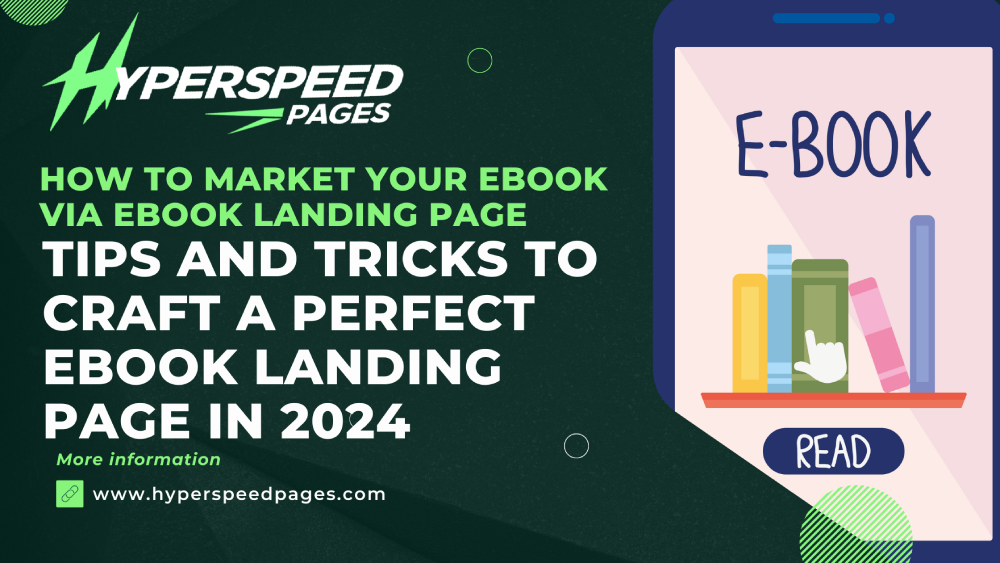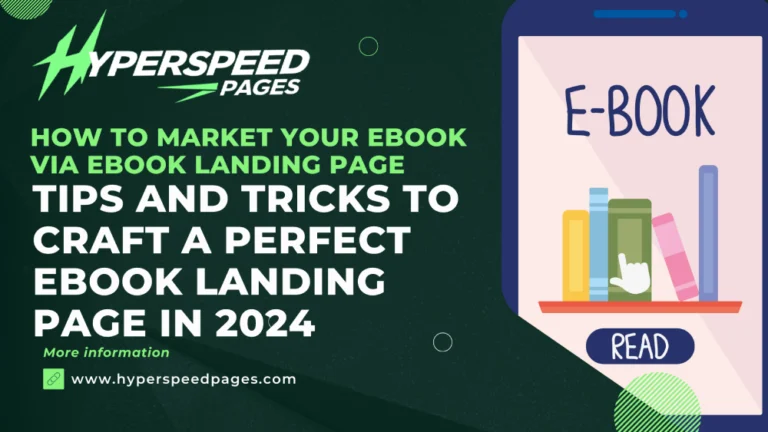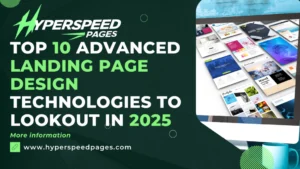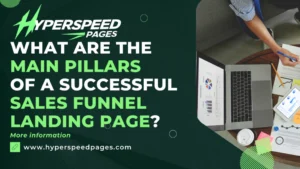
Marketing an ebook effectively involves much more than just writing a compelling book. Crafting a perfect ebook landing page is a blend of art and science, requiring a deep understanding of design principles, user psychology, and search engine optimization (SEO). This guide will walk you through the essential steps to create a high-converting ebook landing page, with a focus on technical aspects.
1. Understanding the Purpose of an Ebook Landing Page
An ebook landing page is a standalone web page designed to promote and sell or give away an ebook. Unlike a typical website page, its sole purpose is to convert visitors into leads or customers. The structure and content of this page should guide visitors through a seamless journey from interest to conversion.
2. Design and Layout Considerations
The design and layout of your ebook landing page are the first things a visitor notices. In 2024, minimalist, user-centric designs are trending, with a focus on responsiveness and accessibility. Here are some key technical aspects:
- Responsive Design: Ensure your web design landing page is fully responsive, meaning it should work flawlessly on desktops, tablets, and mobile devices. This is crucial as mobile users continue to grow, and Google’s mobile-first indexing prioritizes mobile-friendly sites.
- Above-the-Fold Content: Place the most important content, including the ebook title, a compelling headline, and a clear call-to-action (CTA) above the fold. This ensures that users see the key information without scrolling.
- Visual Hierarchy: Use contrasting colors, bold fonts, and size variations to guide the user’s attention to important elements, such as the CTA button. White space should be strategically used to avoid clutter and improve readability.
- High-Quality Images: Include a professional cover image of the ebook, as well as any other relevant visuals. Images should be optimized for fast loading times without compromising quality, as page speed is a critical ranking factor.
- A/B Testing: Regularly perform A/B testing on different design elements like CTA buttons, headlines, and images to determine what converts best. Tools like Google Optimize or Optimizely can be invaluable here.
3. Crafting the Perfect Headline and Subheadline
The headline is arguably the most critical element of your real estate landing page. It should be concise, compelling, and immediately convey the value of the ebook. Personalization and emotional engagement are key trends:
- Use Power Words: Incorporate powerful and emotional words that resonate with your target audience. For example, words like “Unlock,” “Discover,” or “Ultimate” can create a sense of urgency and importance.
- Benefit-Oriented Headlines: Focus on what the reader will gain by downloading the ebook. Instead of just stating the title, highlight the key benefit. For example, “Unlock Proven Strategies to Boost Your Online Sales by 300%.”
- Subheadline for Clarity: Use a subheadline to provide additional context or clarification, especially if the headline is more creative or ambiguous. This ensures that visitors fully understand the value proposition.
4. Optimizing Content for SEO
Search engine optimization is essential for driving organic traffic to your ebook landing page. SEO has become more sophisticated, with search engines like Google emphasizing user experience and content quality:
- Keyword Research: Identify and target relevant long-tail keywords that match the intent of your audience. Tools like Ahrefs, SEMrush, or Google Keyword Planner can help you find keywords with high search volume and low competition.
- On-Page SEO: Optimize your landing page’s meta title, meta description, headers (H1, H2, H3), and URL slug with your target keywords. The title tag should be compelling and include the main keyword, while the meta description should summarize the ebook’s value proposition in a way that entices clicks.
- Content Structure: Use a clear, logical structure with headings and subheadings. This not only improves readability but also helps search engines understand the content’s hierarchy and relevance.
- Internal and External Links: Include internal links to related content on your website and external links to authoritative sources. This can boost your page’s authority and relevance in the eyes of search engines.
- Page Speed Optimization: A slow-loading page can negatively impact both user experience and SEO rankings. Use tools like Google PageSpeed Insights to identify and fix issues, such as large image files, render-blocking JavaScript, or unoptimized CSS.
5. Writing Persuasive Copy
The copy on your ebook landing page should be persuasive and focused on conversion. Here’s how to craft compelling content:
- Address Pain Points: Identify the common pain points or challenges your target audience faces, and explain how your ebook offers solutions. This helps establish relevance and urgency.
- Use Social Proof: Incorporate testimonials, reviews, or endorsements to build trust. Social proof can significantly influence a visitor’s decision to download the ebook.
- Create a Sense of Urgency: Use phrases like “Limited Time Offer” or “Download Now” to create a sense of urgency. This can encourage visitors to take immediate action.
- Keep it Concise: Avoid overwhelming visitors with too much text. Use bullet points, short paragraphs, and clear language to convey the value of the ebook quickly.
6. Call-to-Action (CTA) Optimization
The CTA is the element that converts visitors into leads or customers. Optimizing the CTA is crucial for a high-converting landing page:
- Button Design: The CTA button should be prominently placed and designed to stand out. Use contrasting colors that draw attention without clashing with the overall design.
- Action-Oriented Text: The text on the CTA button should be clear and action-oriented. Instead of generic phrases like “Submit” or “Click Here”, use specific commands like “Download Your Free Ebook” or “Get Instant Access.”
- Multiple CTAs: Depending on the length of your landing page, include multiple CTAs strategically placed throughout the page. This ensures that visitors have ample opportunities to convert, no matter where they are on the page.
- Exit-Intent Popups: Consider using exit-intent popups with a CTA when a user is about to leave the page. This can capture potential leads who might have otherwise bounced.
7. Building Trust with Google E-E-A-T Principles
Google’s E-E-A-T standards emphasize Experience, Expertise, Authoritativeness, and Trustworthiness. Incorporating these elements into your digital marketing landing page can enhance its credibility and SEO performance:
- Author Bio: Include a detailed author bio that highlights your credentials, experience, and expertise in the ebook’s subject matter. This builds trust and authority with your audience.
- Testimonials and Reviews: Display testimonials from industry experts, influencers, or satisfied readers. This reinforces the quality and value of your ebook.
- Privacy Policy and Security Badges: If you’re collecting personal information (e.g., email addresses), clearly state your privacy policy and include security badges (like SSL certification) to reassure visitors that their data is safe.
- Third-Party Endorsements: If your ebook has been featured or endorsed by reputable organizations or media outlets, highlight this on your landing page. Third-party endorsements can significantly boost your credibility.
8. Leveraging Analytics and Tracking
Tracking the performance of your ebook landing page is essential for continuous improvement. Use analytics tools to gather data and make informed decisions:
- Google Analytics: Set up Google Analytics to track key metrics like bounce rate, time on page, conversion rate, and traffic sources. This data will help you understand user behavior and optimize accordingly.
- Heatmaps and Session Recording: Tools like Hotjar or Crazy Egg allow you to visualize where users are clicking and how they navigate your landing page. This can provide insights into what elements are working and which need improvement.
- Goal Tracking: In Google Analytics, set up goals to track specific actions, such as ebook downloads or email sign-ups. This will give you a clear picture of your landing page’s effectiveness.
- Split Testing: Continuously test different versions of your landing page (A/B testing) to identify what drives the best results. This could include testing different headlines, images, or CTA placements.
9. Optimizing for Conversion Rate (CRO)
Conversion Rate Optimization (CRO) is the process of improving your landing page to increase the percentage of visitors who complete the desired action (e.g., downloading the ebook). Here are some advanced CRO strategies:
- Personalization: Use dynamic content that changes based on the visitor’s behavior or demographics. For example, if a user has previously interacted with your content, you could display a personalized message or offer.
- Scarcity Tactics: Implement scarcity tactics, such as limiting the number of free downloads or offering the ebook for a limited time. This can create urgency and prompt immediate action.
- Retargeting Campaigns: Use retargeting ads to bring back visitors who didn’t convert on their first visit. Retargeting can be highly effective in reinforcing your offer and encouraging conversions.
- Lead Magnets: Offer additional lead magnets, such as a free checklist, template, or webinar, to increase the perceived value and incentivize sign-ups.
10. Ensuring Compliance with Legal Standards
Finally, ensure that your ebook landing page complies with relevant legal standards, especially regarding data privacy and accessibility:
- GDPR Compliance: If you’re targeting an audience in the European Union, ensure that your landing page complies with the General Data Protection Regulation (GDPR). This includes obtaining explicit consent for data collection and providing users with the option to opt out or manage their cookie preferences. Additionally, clearly explain how user data will be used and stored, typically within a comprehensive privacy policy.
- Accessibility Compliance: Ensure your landing page is accessible to users with disabilities by following the Web Content Accessibility Guidelines (WCAG). This includes providing alt text for images, using sufficient color contrast, and ensuring that the page can be navigated using a keyboard. Accessibility not only broadens your audience but also aligns with Google’s focus on user experience.
- CAN-SPAM Act Compliance: If you’re collecting email addresses for marketing purposes, ensure that your landing page complies with the CAN-SPAM Act. This U.S. law requires you to provide a clear unsubscribe option and avoid misleading subject lines in your email marketing.
11. Integrating Email Marketing with Your Landing Page
Email marketing is a powerful tool to nurture leads captured through your ebook landing page. Here’s how to effectively integrate email marketing strategies:
- Automated Email Sequences: Set up an automated email sequence to follow up with users who download your ebook. The sequence could include a welcome email, additional resources, and prompts to engage with more of your content or products.
- Segmentation: Segment your email list based on user behavior or demographics to send more personalized and relevant content. For example, you could create different sequences for users who downloaded the ebook but haven’t yet purchased a related product.
- Lead Scoring: Implement lead scoring to prioritize and target the most engaged leads. This involves assigning points based on user interactions (e.g., opening emails, clicking links) and targeting those who show high intent.
- Content Upgrades: Offer content upgrades within your emails, such as additional chapters, worksheets, or related ebooks. This can keep your audience engaged and increase the likelihood of further conversions.
12. Utilizing Social Proof and User-Generated Content
Social proof is a powerful motivator for conversions. Incorporate different forms of social proof on your ebook landing page:
- User-Generated Reviews: Showcase authentic reviews or testimonials from readers who have benefited from your ebook. Real, user-generated content can significantly influence the decision-making process of new visitors.
- Case Studies: If applicable, include short case studies that highlight how your ebook has helped others achieve specific results. This adds a layer of credibility and shows practical applications of your content.
- Endorsements from Influencers: If you’ve collaborated with industry influencers or thought leaders, feature their endorsements prominently on your landing page. This can lend additional authority to your ebook.
- Social Media Mentions: Display social media mentions or shares of your ebook, especially if it has been discussed by well-known personalities or has gained significant attention. This further solidifies the perceived value of your content.
13. Promoting Your Ebook Landing Page Across Channels
Creating a high-converting landing page is just the first step. Promoting it effectively across various channels is essential to drive traffic and conversions:
- Social Media Advertising: Utilize platforms like Facebook, Instagram, LinkedIn, and Twitter to run targeted ad campaigns promoting your ebook. Tailor your ads to specific audience segments based on interests, demographics, or behaviors.
- Search Engine Marketing (SEM): Invest in Google Ads to target keywords relevant to your ebook. SEM allows you to appear at the top of search engine results pages (SERPs) for highly competitive terms, driving immediate traffic to your landing page.
- Content Marketing: Create related blog posts, articles, or videos that link back to your ebook landing page. Content marketing not only drives organic traffic but also establishes you as an authority in your niche.
- Affiliate Marketing: Collaborate with affiliates or partners who can promote your ebook to their audience in exchange for a commission. This can significantly expand your reach and bring in new leads.
- Email Campaigns: Leverage your existing email list to promote the ebook landing page. Personalize the messaging and provide exclusive offers to your subscribers to increase conversion rates.
14. Analyzing and Iterating Your Landing Page
Continuous analysis and iteration are key to maintaining a high-converting ebook landing page. Here’s how to keep your page optimized over time:
- Performance Metrics: Regularly review key performance indicators (KPIs) such as conversion rate, bounce rate, click-through rate (CTR), and average time on page. Use tools like Google Analytics and heatmaps to gather data.
- User Feedback: Collect feedback from users who download your ebook to understand their experience. This could be through follow-up surveys, direct emails, or user interviews. Use this feedback to refine your content and design.
- Content Updates: As trends and user preferences evolve, so should your landing page content. Update the ebook, headlines, and even the design periodically to keep it fresh and relevant.
- Competitor Analysis: Keep an eye on your competitors’ ebook landing pages. Analyze what they’re doing right and identify gaps in your own strategy. Use tools like SEMrush to monitor their keyword rankings and traffic sources.
- SEO Maintenance: SEO is not a one-time task. Continuously update your SEO strategy by monitoring algorithm changes, updating keywords, and building backlinks to your landing page.
Crafting a perfect ebook landing page requires a deep understanding of design principles, SEO, user psychology, and compliance with legal standards. Remember continuous optimization, testing, and iteration are essential to staying ahead of the competition.
SOURCE:




